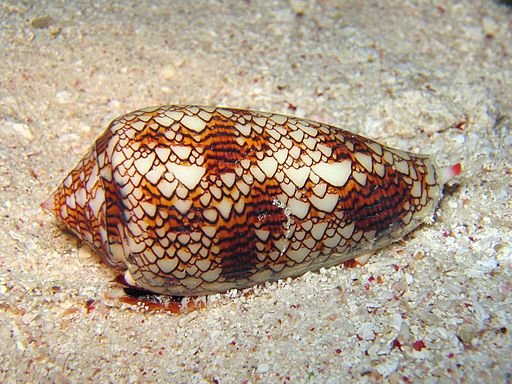Striped Eel Catfish (Gonzui)
I've put these guys first because they are so common. Schools of little striped fish swimming so tightly together they look like a solid ball often about the size of your head . . . a ball of poisonous spines! Although these are pretty common around the island, I've never had any trouble with them. Just don't try to pet them. |
| By Izuzuki (http://www.izuzuki.com/) [CC BY-SA 3.0 (http://creativecommons.org/licenses/by-sa/3.0)], via Wikimedia Commons |
Sea Snakes (Umihebi)
These beautiful blue-and-black striped snakes are usually docile. However, I hear that their venom is as deadly as cobra venom!
Cone Snails (Amboina)
Lionfish (Minokasago)
 |
| By syu-1 (http://photozou.jp/photo/show/1035073/116196386) [CC BY-SA 2.1 jp (http://creativecommons.org/licenses/by-sa/2.1/jp/deed.en)], via Wikimedia Commons |
Portuguese Man-of-War (Katsuo no Eboshi)
 |
| See page for author [Public domain], via Wikimedia Commons"><img alt="Portuguese Man-O-War (Physalia physalis) |
Bottom dwellers:
If you're at a sandy swimming beach, these things aren't so much of a problem, but especially if you're snorkeling, you should watch where you put your feet. Please, folks, don't stand on the coral. This is inconsiderate of living corals, and also dangerous. In case you're worried about getting tired and needing to stand up while snorkeling, why not put some fins on your feet that will help you with propulsion, or at least some old shoes with cushy soles that will keep your feet afloat?
There's a bunch of nasty things you don't want to stand on, and sharp rocks are just the beginning. While some sea urchins are quite a delicacy, none are pleasant to step on. Not always floating frills and tentacles, jellyfish polyps of the genus Stephanoscyphus may be attached to coral or sponges. What appears to be a placid spot of coral may not be so defenceless. Some things to watch for include sea fans, anemones and bristle worms hidden among the coral.
The Yakushima Environment and Cultural Center book, 屋久島の海辺生き物ガイド, also warns about these two curious creatures which I have not been (un)fortunate enough to meet:
Stonefish (Onidaruma Okaze)
 |
| By David Burdick. (NOAA Photo Library: reef0915) [CC BY 2.0 (http://creativecommons.org/licenses/by/2.0) or Public domain], via Wikimedia Commons |
I'm not sure if I would spot this fish if it was half a meter from my face, but apparently they have poisonous spines that can be deadly if stepped on.
Blue-Ringed Octopus (HyoumonDago)
Still want to go swimming? Of course you do! With warm waters and a mix of tropical and cold water fish, Yakushima is a great place to explore the ocean. Just remember, don't touch things if you don't know what they are!
*Copyright note: I've used several images from the Wikimedia Commons. Images without listed copyright information are my own.




No comments:
Post a Comment
Comments will be visible for five days before moderation. Please do not post a request for a hike as a comment